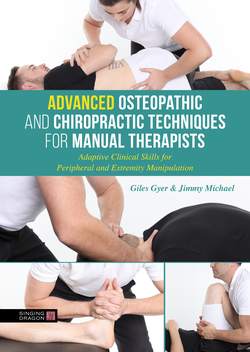Читать книгу Advanced Osteopathic and Chiropractic Techniques for Manual Therapists - Giles Gyer - Страница 5
На сайте Литреса книга снята с продажи.
Introduction
ОглавлениеSpinal manipulation is a specialised form of manual therapy that uses non-invasive ‘hands-on’ treatment techniques to treat musculoskeletal pain and disability. The therapy has proven to be an effective treatment option for the management of various musculoskeletal disorders and is practised worldwide by health practitioners from various specialities, including osteopaths, chiropractors, naturopathic physicians and physiotherapists. However, little is yet understood about the physiological mechanisms of this therapy, especially how it exerts its pain-modulatory effects. Over the past decade, many theories have been proposed to explain the mechanisms of spinal manipulation (Evans 2002; Evans and Breen 2006; Maigne and Vautravers 2003; Potter, McCarthy and Oldham 2005), but the available data from mechanistic studies are insufficient to clarify the short- or long-term clinical outcomes of manipulation.
Most of the early theories that have been proposed to explain the analgesic and hypoalgesic effects of spinal manipulation were heavily focused on the biomechanical changes following the intervention (Evans 2002; Evans and Breen 2006; Potter et al. 2005). In recent years, however, there has been a paradigm shift towards a neurophysiological mechanism of spinal manipulation, as an increasing number of recent studies have reported various neural effects of spinal manipulation such as changes in somatosensory processing, muscle-reflexogenic responses, central motor excitability, motor neurone activity, Hoffmann reflex (H-reflex) responses, sympathetic activity and central sensitisation (Currie et al. 2016; Sampath et al. 2015; Lelic et al. 2016; Pickar 2002; Randoll et al. 2017; Zafereo and Deschenes 2015). These studies have suggested a cascade of neurochemical responses in the central and peripheral nervous system following spinal manipulation. Hence, it has been hypothesised that the observed pain-modulatory effects of spinal manipulation are largely due to neurophysiological mechanisms mediated by peripheral, spinal and supraspinal structures. These mechanisms have been thought to be triggered by mechanical stimulus or biomechanical forces applied during the manipulative act.
To date, Pickar’s (2002) is the only review to provide a theoretical framework for the neurophysiological effects of spinal manipulation. Although Bialosky and colleagues (2009) later proposed a comprehensive model and a new framework to visualise potential individual mechanisms associated with pain reduction, their work was based on different forms of manual therapy and not exclusive to spinal manipulation alone. Hence, there has been a need for a comprehensive review that presents an updated framework based on the current knowledge and understanding of the neurophysiological effects of spinal manipulation. On the other hand, over the last decade a growing number of mechanistic studies have been conducted to understand the neurophysiological mechanisms of spinal manipulation. These studies have demonstrated various neural responses following manipulation. However, no review has been written to evaluate the relevance of these findings with regard to the proposed theories as well as the observed clinical effects. Therefore, the purpose of this chapter is to examine all the recent findings on the neurophysiological effects of spinal manipulation and review their relevance with respect to the improved clinical outcomes of spinal manipulation.
